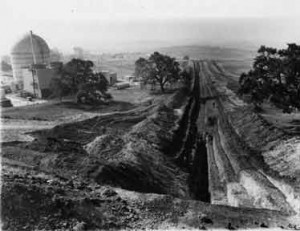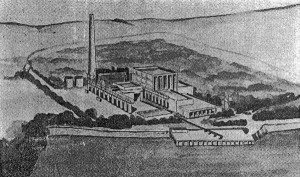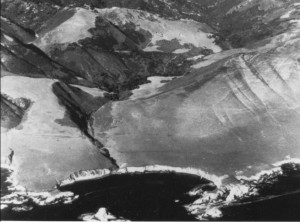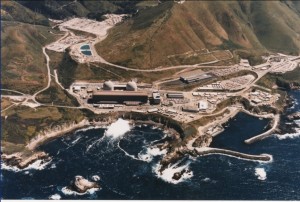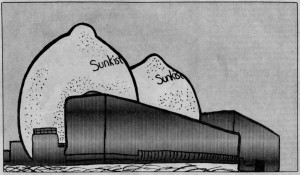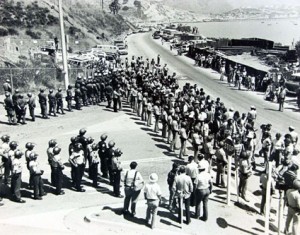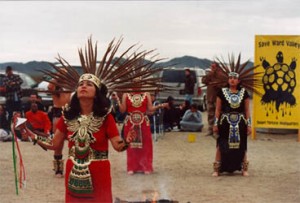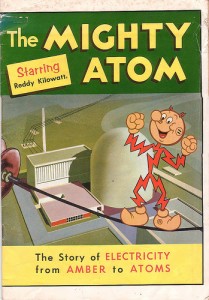 With the closure of San Onofre, its time to celebrate one of the most important victories to date in the struggle to protect the environment in California’s long and prominent role on this issue.
With the closure of San Onofre, its time to celebrate one of the most important victories to date in the struggle to protect the environment in California’s long and prominent role on this issue.
You wouldn’t know it by any major media outlet, almost anywhere on this planet, that there has been a fifty year old battle going on against nuclear energy, and it all started in California in 1958 when the Pacific Gas & Electric Company (PG&E) attempted to construct a four unit complex less than a thousand yards from the epicenter of the 1906 earthquake that leveled San Francisco. Since then, California, which was at the cutting edge in the rush to develop nuclear energy, now represents the exact opposite – the cutting edge of renewable energy and energy efficiency.
During the heady pro-nuke days of yore, General Electric (GE), opened up its nuclear division in San Jose California. But as a sign of things to come, all the reactor designs picked by the state’s utilities weren’t from GE. That is, except the first facility built in California in 1957 called Vallecitos. What was true to form would be the facility not far from the Livermore labs would later be found to be close to an active earthquake fault.
The battle over PG&E’s proposed four reactor unit near Bodega Bay would not only be the first no nukes battle in the country, it would also be a bitter loss for the country’s largest electric company. The struggle also dove tailed into the growing free speech movement at UC Berkeley as well as drawing a sleepy old republican hiking club out of the dustbin of history and into the limelight, known as the Sierra Club.
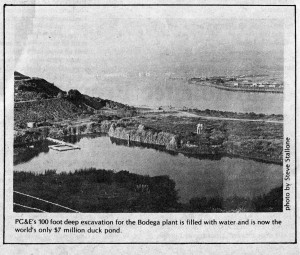 During the fight, PG&E would make claims like their infamous “Tao Effect” that the bigger the building the smaller impacts an earthquake would. Another one that inflamed the war was their claim that they could safely build a reactor in downtown San Francisco. The battle that would help set the framework and strategies for activists right up to the present, as seismic safety came to play a critical role time and time again. PG&E would lose. And lose hard at Bodega Bay. Their $8 million excavation of the site would end up a duck pond now know in the area as the “Hole in the Head”, which pretty much sums up the tone of the era with a flood of PR tactics were launched to promote nuclear anything, from nuclear powered cars to airplanes, or the magical claim that nuclear electricity would be “too cheap to meter”.
During the fight, PG&E would make claims like their infamous “Tao Effect” that the bigger the building the smaller impacts an earthquake would. Another one that inflamed the war was their claim that they could safely build a reactor in downtown San Francisco. The battle that would help set the framework and strategies for activists right up to the present, as seismic safety came to play a critical role time and time again. PG&E would lose. And lose hard at Bodega Bay. Their $8 million excavation of the site would end up a duck pond now know in the area as the “Hole in the Head”, which pretty much sums up the tone of the era with a flood of PR tactics were launched to promote nuclear anything, from nuclear powered cars to airplanes, or the magical claim that nuclear electricity would be “too cheap to meter”.
But of course, PG&E was not to be deterred by its loss, and in fact made claims that it had over 60 nuclear reactors on the drawing board planned for their service territory, even a floating reactor! The company has a long history of heavy handed politics in the state going back to one of the countries first and bitterest environmental battles at Hetch Hetchy. As it became clear that PG&E would lose at Bodega Bay, it sought to engage the Sierra Club’s leadership as part of the nuclear industry’s massive campaign to convince the country that nuclear energy would be the ideal solution to replace coal as the country’s primary source of electricity. Actually the issue was moot here, since the state doesn’t have any coal. Even before Bodega had bit the dust, PG&E bought a stretch of land down near San Luis Obispo called Nipomo Dunes, a favorite hiking spot of nature lovers and the Sierra Club’s chapter in the area.
A secret deal was between the wife of the Club’s president (Doris Leonard) and PG&E was struck that they would find an alternative to the Dunes. Doris would eventually be elected to PG&E’s board, in what would become one of the longest running nuclear power fights – when the company announced plans to build five reactors at Diablo Canyon. The alternative to Nipomo Dunes couldn’t have been worse, picking a proposed state park along the last coastal wilderness area in Southern California, also the home to some of the largest Oak trees in the world as well as being a sacred Chumash spot looking out over what the Spanish called Diablo Cove. Getting the name as a result of the intense shaking from earthquakes the first Europeans experienced soon after its discovery. The Diablo Cove would also be home to one of the largest populations of Abalone on the west coast, and a favorite spot for local fishing folk, who would be the first to do civil disobedience at Diablo. It was estimated that over 10,000 Abalone were killed the first time the reactors were hot tested.
The deal was cut. When the only member of the Sierra Club board who had any real knowledge about the sites significance was in Europe, PG&E would borrow Frank Sinatra’s Lear Jet, wining and dining the Club’s board in a flyover of Diablo with the comedian Danny Kaye (he would later turn anti-nuclear) on board as entertainment. The vote was a victory for PG&E, that was quickly followed by an order from the clubs offices in San Francisco that no club chapters would be allowed to opposed Diablo Canyon.
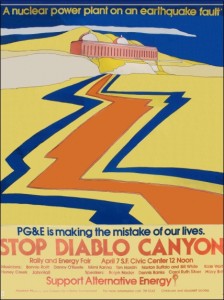 Well, upon the announcement, the San Luis chapter in utter concern would form a new group called the Scenic Shoreline Preservation Conference that would then on, demand that seismic investigations be done, bringing out the fact that Santa Barbara just to the south had been destroyed by a major series of earthquakes between 1925 and 1927, including the collapse of a 700 foot long dam. PG&E would use it same crack team of PR specialist and geologists from the Bodega struggle, claiming that there was no danger, even though they kept secret documents showing possible faulting directly under the planned site. Shell geologists had discovered the Hosgri Fault in the mid 60’s but PG&E claims it never heard about the discovery, until an L.A Times reporter ran across the information in 1972 after the first two units were almost done. The next day the Sierra Club lawyer, oops Shoreline Preservation Conference lawyer was found dead in his car who had spent years trying to get the NRC to investigate earthquake dangers. It took nearly 3 more years before the NRC would finally get around to ordering PG&E to redesign and strengthen the reactors, driving the initial price tag of about $300 million to over $2.1 billion, delaying the opening until 1979.
Well, upon the announcement, the San Luis chapter in utter concern would form a new group called the Scenic Shoreline Preservation Conference that would then on, demand that seismic investigations be done, bringing out the fact that Santa Barbara just to the south had been destroyed by a major series of earthquakes between 1925 and 1927, including the collapse of a 700 foot long dam. PG&E would use it same crack team of PR specialist and geologists from the Bodega struggle, claiming that there was no danger, even though they kept secret documents showing possible faulting directly under the planned site. Shell geologists had discovered the Hosgri Fault in the mid 60’s but PG&E claims it never heard about the discovery, until an L.A Times reporter ran across the information in 1972 after the first two units were almost done. The next day the Sierra Club lawyer, oops Shoreline Preservation Conference lawyer was found dead in his car who had spent years trying to get the NRC to investigate earthquake dangers. It took nearly 3 more years before the NRC would finally get around to ordering PG&E to redesign and strengthen the reactors, driving the initial price tag of about $300 million to over $2.1 billion, delaying the opening until 1979.
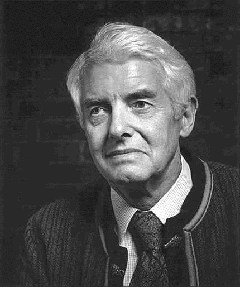
David Brower
The original announcement in the mid 60’s of the Sierra Club’s endorsement of Diablo was nothing short of an 8.0 earthquake within the club’s membership as its controversial executive director, David Brower and Martin Litton who had been in Europe were very angry at the decision. There would be an attempt to reverse the decision within the club. It would lose. Brower would be forced to resign from the club, and rather than just disappear took many of the club’s activists with him to form Friends of the Earth (FOE), that would eventually go worldwide. FOE would eventually attract a brilliant physicist by the name of Amory Lovins into FOE who would coin the term nuclear agenda as the “Hard Path”, going on right up to the present as one of the nuclear industry’s biggest thorns, when built a house in the Rocky Mountains that was a net exporter of electricity.
 Throughout its history, whether its been in the UK, down under in Australia or the United States, it has long been dedicated to the environment and opposition to nuclear energy development, with them playing a major role in the battle to not only keep San Onofre from restarting at the present time, but also when Southern California Edison first announced plans to construct them in the mid 1970’s.
Throughout its history, whether its been in the UK, down under in Australia or the United States, it has long been dedicated to the environment and opposition to nuclear energy development, with them playing a major role in the battle to not only keep San Onofre from restarting at the present time, but also when Southern California Edison first announced plans to construct them in the mid 1970’s.
The PR claims by the electric utility industry that it would replace the horrible impacts of coal (smog and acid rain) in the 1960’s with nuclear energy proved to be bulloney as the coal industry never blinked an eye in expanding its use. It was this broken promise and the growing controversy over nuclear by the mid 1970’s that turned the Sierra Club back into the no-nukes camp.
Not to mention the growing awareness of the dangers of accidents and nuclear waste as the long country started to awaken from the secret deals and massive financing by the federal government that made the commercialization possible. There was also the attempt to go from relative small reactor designs to the far more lucrative thousand megawatt designs that started to worry more people.
By 1975, soon after President Nixon’s call for the country to build a thousand nuclear stations by the 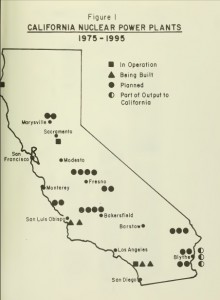 year 2000 was announced, California was on the verge of opening up Diablo Canyon, while the Humboldt Bay nuclear facility had been put online in 1964, followed by Southern California Edison’s San Onofre unit 1 in 1967. A state report documented the active plans to build 21 nuclear stations across the state with 15 of them in the central valley along the Peripheral Canal, the very canal that has long been at the center of north south tensions in the state with ever growing amounts of water from the north having impacts across the northern half of the state. Imagine today, if those reactors had been allowed to be built and what the impacts would have been on the state’s water supplies – The people of Southern California would have been having to drink their own special version of nuclear cool-aid 24-7!
year 2000 was announced, California was on the verge of opening up Diablo Canyon, while the Humboldt Bay nuclear facility had been put online in 1964, followed by Southern California Edison’s San Onofre unit 1 in 1967. A state report documented the active plans to build 21 nuclear stations across the state with 15 of them in the central valley along the Peripheral Canal, the very canal that has long been at the center of north south tensions in the state with ever growing amounts of water from the north having impacts across the northern half of the state. Imagine today, if those reactors had been allowed to be built and what the impacts would have been on the state’s water supplies – The people of Southern California would have been having to drink their own special version of nuclear cool-aid 24-7!
But something happened on the way to the Colosseum. The state, pretty much the home to the modern environmental movement, that took off as part of the student movement across the state following the massive oil spills off the Santa Barbara Coast. It would be Governor Reagan’s crass agenda to destroy one of the most amazing higher education systems in the world, that pretty much died with the passage of Prop 13 in 1979. The days of getting a college education for just a couple of hundred dollars a semester is now but a distant dream.
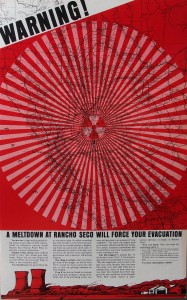 As part of the amazing cultural shifting taking place, a number of new environmental groups, from the NRDC, EDF would form. Including what would be the largest largest branch of Greenpeace movement in the world in San Francisco. Yes, folks, Greenpeace was a movement pretty much destroyed by our favorite pro-nuke gospel boy, Patrick Moore and his Gang of Four Board in Vancouver in 1979 when he was at the helm of that chapter. The details are a bit too hot for the planet, but the end result of the scandal following nearly a half million dollar internal legal battle resulted in the modern day version of Greenpeace, the NGO to be snatched away from Baghdad by the Bay on their way to the DC Beltway, as did most of their original intentions.
As part of the amazing cultural shifting taking place, a number of new environmental groups, from the NRDC, EDF would form. Including what would be the largest largest branch of Greenpeace movement in the world in San Francisco. Yes, folks, Greenpeace was a movement pretty much destroyed by our favorite pro-nuke gospel boy, Patrick Moore and his Gang of Four Board in Vancouver in 1979 when he was at the helm of that chapter. The details are a bit too hot for the planet, but the end result of the scandal following nearly a half million dollar internal legal battle resulted in the modern day version of Greenpeace, the NGO to be snatched away from Baghdad by the Bay on their way to the DC Beltway, as did most of their original intentions.
A couple of memorable Greenpeace short stories includes the kind of feelings at the time. Right after the Three Mile Island (TMI) disaster, a handful of folks spontaneously decided to drive out to Rancho Seco and jumped the facility’s fence and get arrested. Mind you, the entire staff had gone out to watch China Syndrome when it came out, just weeks before TMI. A few years later, one of the more dedicated volunteer staffers in SF, who refused to take any money for his work, started up a GP office in Chicago. He would take a TV News camera crew out to the Zion nuclear reactor shortly after Israel had bombed a nuclear facility under construction in Iraq into oblivion, and then proceeded to shoot fire works into the side of the reactor while the news crew filmed him. The utility’s security staff never saw it until it was on the six o’clock news that night setting off a fire storm over nuclear security in the area.
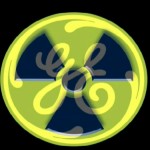 Back to the mid 1970’s though, with the growing concern over the new super sized reactor designs be ordered in ever numbers (economy of scale crap), three nuclear engineers at GE’s San Jose center would quit over the plans by the company to put the Mark I design into production. The three would go on to form MHB Associates that would be a prominent tech support team against nuclear power in the US, with Greg Minor, eventually moving to Canada where he is still active (including a book on uranium mining issues), and can be counted on by the California Energy Commission (CEC) to produce presentations on nuclear energy.
Back to the mid 1970’s though, with the growing concern over the new super sized reactor designs be ordered in ever numbers (economy of scale crap), three nuclear engineers at GE’s San Jose center would quit over the plans by the company to put the Mark I design into production. The three would go on to form MHB Associates that would be a prominent tech support team against nuclear power in the US, with Greg Minor, eventually moving to Canada where he is still active (including a book on uranium mining issues), and can be counted on by the California Energy Commission (CEC) to produce presentations on nuclear energy.

John Gofman
Other groups would emerge. In the mid 60’s a health physicist that had been part of the Manhattan project named Dr. John Gofman would be hired with an associate Dr. Tamplin to do study for the Department of Energy proving that radiation dangers were far less than the growing anti-nuclear weapons movement was claiming. Gofman would do the study and find the opposite. He was threatened not to publish but did so anyway. They took his staff away and made him a department head of one person. He would leave to form his own group, Committee for Nuclear Responsibility around his own technical work, including numerous books for the next 35 years. His presentations in the bay area would help play a key role in launching the Abalone Alliance in May of 1977. John would also call for Nuremberg trials for the early nuclear establishment because of their role in covering up the dangers of radiation to the public.
Another group to arrive in the state would be Dan Hirsch’s Committee to Bridge the Gap that would be involved with Diablo Canyon by the time PG&E was forced into its multiple rebuild of Diablo Canyon. After Chernobyl he’d bring out the barely known fact that the Department of Energy was operating a reactor similar to Chernobyl called the N Reactor at Hanford. It had no containment vessel of any kind, and as a result was almost immediately closed.
At the same time faculty at UC Berkeley exposed the fact that the campus mini-reactor at Etcheverry Hall was sitting right atop an active fault line. It too was closed down in short order due to public pressure after Chernobyl. An activist actually spotted the reactor outside of Sacramento a number of years later, waiting for a permanent burial site.
Dan Hirsch has spent years documenting and 1959 meltdown just north of Los Angeles at the Simi Valley nuclear facility operated by Rockedyne. The struggle to document the nearly secret disaster and its coverup, not to mention the cleanup that is still going on today. He also played a prominent role in the battle to stop the Ward Valley nuclear waste dump.
And of course, the twenty five year long battle to keep Diablo Canyon from operating was also a major reason for the Abalone Alliance’s statewide campaign, which at its peek included over 60 affiliated groups including Greenpeace and the Southern California Alliance for Survival that at one point had over 100,000 members.
Another spinoff from David Brower would be the Earth Island Institute that could be counted on to produce coverage of the nuclear battles as did the North Coast Ecology Center, where the battles by the Redwood Alliance would be covered in the successful bid to shut PG&E’s Humboldt Bay nuke down. The Alliance would also play a prominent role in the CPUC hearings on Diablo Canyon, especially on decommissioning rate issues.
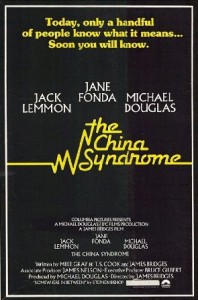 Former Chicago seven member and state senator Tom Hayden would also jump into the anti-nuclear campaign with his wife Jane Fonda, who starred in the 1979 Hollywood movie “China Syndrome”. Jane would peddle her exercise video as a fundraiser, helping out in the 3 year battle to shutdown Rancho Seco. The nuclear reactor outside of Sacramento, and a twin to the infamous Babcock and Wilcox design that melted down at Three Mile Island. The Ranch would also be the proud owner of the 3rd worst US incident in history with a steam dry-out incident in 1978. After Chernobyl, the campaign to close the Ranch would take a number of local votes by the publicly owned Sacramento Municipal Utility District, but in June of 1989, it finally won, turning SMUD into one of the cheapest sources of electricity in the state.
Former Chicago seven member and state senator Tom Hayden would also jump into the anti-nuclear campaign with his wife Jane Fonda, who starred in the 1979 Hollywood movie “China Syndrome”. Jane would peddle her exercise video as a fundraiser, helping out in the 3 year battle to shutdown Rancho Seco. The nuclear reactor outside of Sacramento, and a twin to the infamous Babcock and Wilcox design that melted down at Three Mile Island. The Ranch would also be the proud owner of the 3rd worst US incident in history with a steam dry-out incident in 1978. After Chernobyl, the campaign to close the Ranch would take a number of local votes by the publicly owned Sacramento Municipal Utility District, but in June of 1989, it finally won, turning SMUD into one of the cheapest sources of electricity in the state.
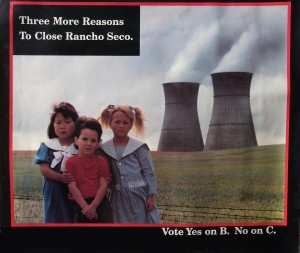 In a surprising moment that played a dramatic role, the Ranch had been experiencing a growing number of shutdowns and technical problems with a serious failure on the 10th anniversary, yep to the date, of the Three Mile Island disaster. In an even more ominous move, PG&E offered to buy the Ranch from SMUD, fix it up and continue running it. That didn’t go over well with the region, as SMUD which used to be part of PG&E had to fight for nearly 25 years to finally free itself from the company, which at the time was the largest electric utility in the US. The SMUD campaign would launch a number of people’s career’s like Ed Smeloff who is a prominent leader in renewable energy community today.
In a surprising moment that played a dramatic role, the Ranch had been experiencing a growing number of shutdowns and technical problems with a serious failure on the 10th anniversary, yep to the date, of the Three Mile Island disaster. In an even more ominous move, PG&E offered to buy the Ranch from SMUD, fix it up and continue running it. That didn’t go over well with the region, as SMUD which used to be part of PG&E had to fight for nearly 25 years to finally free itself from the company, which at the time was the largest electric utility in the US. The SMUD campaign would launch a number of people’s career’s like Ed Smeloff who is a prominent leader in renewable energy community today.
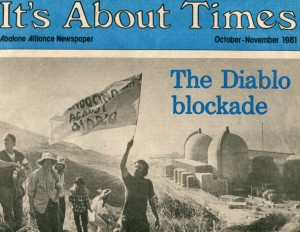 The original Energy Net name was also part of the statewide no nuke campaign by activists promoting renewable energy, and local energy efficiency programs, that were eventually taken over by PG&E with the horrible help by NRDC in the 1980’s. The network would eventually be replaced with the home grown solar movement, that included Home Power Magazine and the independent solar movement on rural Northern California houses where PG&E refused to go. It only took a brief request from one of the original organizers to grab the name, making it one of the first online anti-nuke services in the country going back to 1988. Yep we were actually on the worldwide FidoNet as well as PeaceNet prior to the advent of the Internet, publishing the Radiation Bulletin since 1985 as a replacement to the Abalone Alliance’s It’s About Times newsletter that ran from 1977 to 1985.
The original Energy Net name was also part of the statewide no nuke campaign by activists promoting renewable energy, and local energy efficiency programs, that were eventually taken over by PG&E with the horrible help by NRDC in the 1980’s. The network would eventually be replaced with the home grown solar movement, that included Home Power Magazine and the independent solar movement on rural Northern California houses where PG&E refused to go. It only took a brief request from one of the original organizers to grab the name, making it one of the first online anti-nuke services in the country going back to 1988. Yep we were actually on the worldwide FidoNet as well as PeaceNet prior to the advent of the Internet, publishing the Radiation Bulletin since 1985 as a replacement to the Abalone Alliance’s It’s About Times newsletter that ran from 1977 to 1985.
Again, as part of the resignation of Minor, Hubbard and Bridenbough (MHB) from GE, as well as an NRC inspector named Peter Falk (he wrote a book called Silent Bomb), the state’s growing environmental movement decided it was time to call for the closure of the state’s nuclear reactors. An initiative attempt in 1972 didn’t fair so well. However, a group eventually led by one of the UC students who also was part of the Bodega Bay battle, David Pesonen and Californians for Nuclear Safeguards would launch the 1975 Proposition 15 statewide initiative.
PG&E and the nuclear industry would spend millions of dollars to defeat the initiative, but in the fear that it might pass, agreed to support state legislation that would put a moratorium on any further nuclear reactor orders until a solution for spent nuclear fuel was in place. PG&E would later regret this as there is still no answer to the problem. The company would take the law all the way to the US Supreme Court in 1983 but lose. Eventually at least 17 other states around the country would also follow suit passing similar moratoriums on development that have been a prominent reason why there have been no new reactors since the 1970’s in the US.
Another major victory would take place when an alliance of farmers and activists would come together to stop another attempt to build the largest nuclear facility in the world in conservative Kern County. The Central Valley battle in 1978 would be won because of the impacts it would have had on the state’s limited fresh water supplies already under stress due to the growing demand of urban growth in Southern California. And of course, J Brown was actively attempted to expand the canal during his time in office… Hmm…
There was even a plan to develop the entire Big Sur region, calling for two reactors half way between San Luis Obispo and Monterrey. CalTran’s role in the now dead scheme was to make a major highway along the coast to help open up the region to developers. Thank goodness their plan was fought tooth and nail, never to see the light of day.
Probably one of the most important, but least known of the movement’s victories took place when activists in Santa Cruz were able to stop PG&E from constructing another 4 unit complex on the coast a few miles from what would be the epicenter of the 1989 Loma Prieta quake that caused over $10 billion in damages.
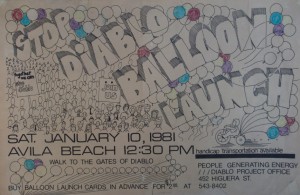 By the early 80’s PG&E’s reckless pro-nuclear agenda in the state had destroyed their legitimacy to the point that even the state’s governor came out in opposition to nuclear power during the June rally in 1979 sponsored by the Abalone Alliance. He would secretly gave limited resources for another ballot initiative that would have permanently made it impossible financially operate reactors in the state. Sadly, a major inside player in the Sane Freeze campaign that got wind of the plan was able to block it at the last minute by pulling the strings on its funding, resulting in only Sane/Freeze initiative on the ballot that year. Governor Moonbeam would also give resources to the legal fight at Diablo Canyon, but not be nearly as supportive as a number of eastern states that were challenging the NRC on many fronts.
By the early 80’s PG&E’s reckless pro-nuclear agenda in the state had destroyed their legitimacy to the point that even the state’s governor came out in opposition to nuclear power during the June rally in 1979 sponsored by the Abalone Alliance. He would secretly gave limited resources for another ballot initiative that would have permanently made it impossible financially operate reactors in the state. Sadly, a major inside player in the Sane Freeze campaign that got wind of the plan was able to block it at the last minute by pulling the strings on its funding, resulting in only Sane/Freeze initiative on the ballot that year. Governor Moonbeam would also give resources to the legal fight at Diablo Canyon, but not be nearly as supportive as a number of eastern states that were challenging the NRC on many fronts.
As mentioned, the Diablo Canyon battle would rage for over 25 years, originally estimated to cost a bit over $300 million, eventually costing $5.8 billion in construction costs and over $7 billion more in financing costs. At the peak of the war, PG&E almost went bankrupt, and after the 2nd rebuild order by the Nuclear Regulatory Commission, shortly after the Abalone Alliance’s largest nuclear power blockade in US history (1,900 arrests) in September 1981, the company couldn’t find any new financing for the $2.1 billion facility anywhere in the world, until President Reagan secretly loaned the company nearly $2.5 billion from the Environmental Protection Agency!
Other groups to launch during the era would be the Mother’s for Peace, which would become the primary legal intervenors at Diablo Canyon and still on the job nearly forty years later. Another group, the Redwood Alliance would take on the battle to close the country’s dirtiest reactor, PG&E’s Humboldt Bay facility in northern California. Within just a few years, seismic concerns would shut down the state’s first reactor at Vallecitos, leaving only a small unit running, then Humboldt Bay, and of course lead to order to rebuild Diablo, and Public Citizen’s battle to close San Onofre’ unit one which was also was found to be near active faults, including a massive 7.5 quake just a few miles away in 1812.
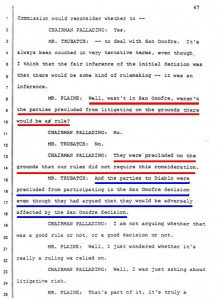 Even though a handful of activists who were originally part of the Mother’s For Peace would break from them to help start the Abalone Alliance, they have continued to be an important part of the state’s no nukes legacy, especially with their legal battles with PG&E around spent fuel storage, but not to mention the ground breaking legal battle that went all the way to the US Supreme Court when former NRC Commissioner James Asselstine leaked the NRC’s transcripts in late 1984 to a major TV station in San Francisco on how they broke their own rules in licensing both Diablo Canyon as well as San Onofre without first holding legally binding hearings over evacuation planning at the facilities. The infamous quotes of the Chairman about earthquakes being just another natural phenomena, no different from rain or snow couldn’t shown just how ignorant the supposed political appointees were that did pretty much everything in their power to keep the struggling nukes from being stopped before they even started by opponents.
Even though a handful of activists who were originally part of the Mother’s For Peace would break from them to help start the Abalone Alliance, they have continued to be an important part of the state’s no nukes legacy, especially with their legal battles with PG&E around spent fuel storage, but not to mention the ground breaking legal battle that went all the way to the US Supreme Court when former NRC Commissioner James Asselstine leaked the NRC’s transcripts in late 1984 to a major TV station in San Francisco on how they broke their own rules in licensing both Diablo Canyon as well as San Onofre without first holding legally binding hearings over evacuation planning at the facilities. The infamous quotes of the Chairman about earthquakes being just another natural phenomena, no different from rain or snow couldn’t shown just how ignorant the supposed political appointees were that did pretty much everything in their power to keep the struggling nukes from being stopped before they even started by opponents.
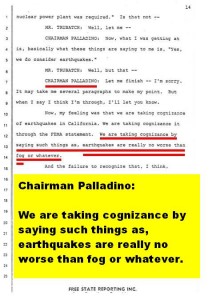 t would be one of the biggest potential wins, but turn into one of the countries darkest constitutional moments when another major consumer activist group called TURN would succeed in their demands that PG&E be forced to submit to allowing the organization to place its own commentary in the company’s electric bills, as a way to educate ratepayers about the battles going on not just with nuclear but other controversies as well. Ralph Nader would launch a nationwide campaign model based on TURN’s growing success here, called the CUB movement or Citizen’s Utility Board campaign to reign in the power of PR – Propaganda machine being used by private electric companies across the country to promote nuclear power development.
t would be one of the biggest potential wins, but turn into one of the countries darkest constitutional moments when another major consumer activist group called TURN would succeed in their demands that PG&E be forced to submit to allowing the organization to place its own commentary in the company’s electric bills, as a way to educate ratepayers about the battles going on not just with nuclear but other controversies as well. Ralph Nader would launch a nationwide campaign model based on TURN’s growing success here, called the CUB movement or Citizen’s Utility Board campaign to reign in the power of PR – Propaganda machine being used by private electric companies across the country to promote nuclear power development.
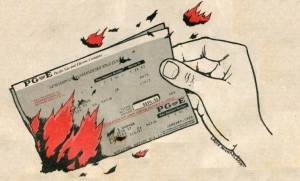 The California Public Utilities Commission, would finally agree with TURN and order PG&E to allow the non-profit group the right to put its own comments in PG’E’s bill. PG&E would take the issue to the US Supreme court, and win in 1986, playing a key role in the collapse of the national CUB movement. The same ruling has had a dramatic impact on first amendment rights ever since, with corporations now using their immense financial resources to trump our individual rights. And of course this goes all the way back to the original Stephen Fielding ruling giving person-hood to corporations in the infamous Central Pacific Railroad vs. Santa Clara County supreme court decision led by the railroad’s own handpicked Supreme Court Justice Fielding… Let’s just say that Justice Fielding had a long an illustrious judicial career in California working for the railroad, building up his early career by taking California’s land from the Spanish ranchers from 1860 onward.
The California Public Utilities Commission, would finally agree with TURN and order PG&E to allow the non-profit group the right to put its own comments in PG’E’s bill. PG&E would take the issue to the US Supreme court, and win in 1986, playing a key role in the collapse of the national CUB movement. The same ruling has had a dramatic impact on first amendment rights ever since, with corporations now using their immense financial resources to trump our individual rights. And of course this goes all the way back to the original Stephen Fielding ruling giving person-hood to corporations in the infamous Central Pacific Railroad vs. Santa Clara County supreme court decision led by the railroad’s own handpicked Supreme Court Justice Fielding… Let’s just say that Justice Fielding had a long an illustrious judicial career in California working for the railroad, building up his early career by taking California’s land from the Spanish ranchers from 1860 onward.
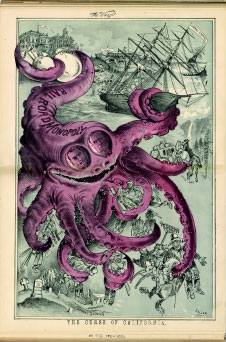 PG&E would also use its immense political resources, as part of the original Octopus in the state – the massive Southern Pacific Railroad Empire that had long ruled the state’s banks, real estate, electric, transportation, and telephone companies. They would carry out the most insidious of attacks on the growing opposition movement in the state, including never investigated allegations of spying on the movement. It was discovered after one of the Abalone’s earl blockades that a substantial number of those arrested were undercover cops. And of course, we could go all the way back to 1916 when the company used a Private Dick from Pinkerton to finger one of the most popular organizers against PG&E – a guy named Tom Mooney – putting him behind bars until 1940.
PG&E would also use its immense political resources, as part of the original Octopus in the state – the massive Southern Pacific Railroad Empire that had long ruled the state’s banks, real estate, electric, transportation, and telephone companies. They would carry out the most insidious of attacks on the growing opposition movement in the state, including never investigated allegations of spying on the movement. It was discovered after one of the Abalone’s earl blockades that a substantial number of those arrested were undercover cops. And of course, we could go all the way back to 1916 when the company used a Private Dick from Pinkerton to finger one of the most popular organizers against PG&E – a guy named Tom Mooney – putting him behind bars until 1940.
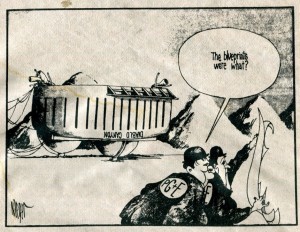 One of the Octopus’s corporate tentacles was the Pacific (watch that <- word) State’s Legal Foundation that was brought into carry out a legal assault on the Abalone Alliance shortly after the 1981 blockade. They would convince San Luis Obispo County to jointly file a lawsuit against the Abalone Alliance to pay for the costs of the blockade out of the AA’s membership’s property! One of the largest law firms in country would take up the challenge which would eventually go all the way to the US Supreme Court over the next five years in one of the first and most brutal examples of SLAPP suits. The Abalone was ordered by Morrison and Forester to not mention the suit in public, in exchange for their Pro-Bono defense.
One of the Octopus’s corporate tentacles was the Pacific (watch that <- word) State’s Legal Foundation that was brought into carry out a legal assault on the Abalone Alliance shortly after the 1981 blockade. They would convince San Luis Obispo County to jointly file a lawsuit against the Abalone Alliance to pay for the costs of the blockade out of the AA’s membership’s property! One of the largest law firms in country would take up the challenge which would eventually go all the way to the US Supreme Court over the next five years in one of the first and most brutal examples of SLAPP suits. The Abalone was ordered by Morrison and Forester to not mention the suit in public, in exchange for their Pro-Bono defense.

PG&E’s true Identity
Pacific State’s suit would fail at every court level, only to be withdrawn days before it was due to be heard before the full court. It played a serious role in the collapse of the Abalone Alliance. But probably more so, was the brutal media coverage, essentially censoring any and all news coverage of anything nuclear power for nearly a decade around the San Francisco Bay Area, where a massive direct action community had evolved as a result of the 1981 blockade. Most activists, rather than travel down to Diablo instead shifted to local actions around the Livermore Labs up until 1985 with the Livermore Action Group.
 During the year leading up to the big blockade, one of the local affiliates had the pleasure of having a spy in the notoriously conservative SF Chronicle. Details of how the paper would intentionally manipulate coverage were just plain boggling. A final example of their unjust behavior took place on the day the above SLAPP lawsuit was finally ended. The story was on the Obituary page in the Bay Area, but front page news on their south coast version. The censorship of nuclear news was so absolute that we literally had to hire a clipping service on the east coast to get any news beyond our newsletter exchange network. If they could have gotten away with it, they’d probably not even covered TMI! Their Chernobyl coverage was nothing less than a full scale red baiting campaign.
During the year leading up to the big blockade, one of the local affiliates had the pleasure of having a spy in the notoriously conservative SF Chronicle. Details of how the paper would intentionally manipulate coverage were just plain boggling. A final example of their unjust behavior took place on the day the above SLAPP lawsuit was finally ended. The story was on the Obituary page in the Bay Area, but front page news on their south coast version. The censorship of nuclear news was so absolute that we literally had to hire a clipping service on the east coast to get any news beyond our newsletter exchange network. If they could have gotten away with it, they’d probably not even covered TMI! Their Chernobyl coverage was nothing less than a full scale red baiting campaign.
With the NRC licensing of both San Onofre and Diablo Canyon between 1983-85, the movement against nuclear power slowed down until Chernobyl, which then ignited the battle to close the Ranch. The only other activity of note was 4 year battle within the California Public Utilities Commission (CPUC) on who would pay how much for the controversial nuclear facilities that had all gone way over their original construction budgets. A year before Chernobyl, Forbes Magazine would say the following:
“The failure of the U.S. nuclear power program ranks as the largest managerial disaster in business history, a disaster on a monumental scale. The utility industry has already invested $125 billion in nuclear power … only the blind, or the biased, can now think that most of the money has been well spent.”
They would go onto claim that the anti-nuclear movement had nothing to do with the collapse. However, we no better! If not for activists and groups across the state, California would have been used as a shining model of nuclear development. Instead the opposite was clearly just one of the reasons why the media has intentionally attempted to wipe out even the slightest mention of what has happened to make the state just the opposite!
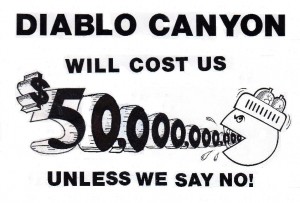 The state of California would be outspent 10 to 1 in its attempt to limit the amount of money that PG&E wanted for Diablo Canyon, spending over $110 million in legal fees in what was the largest case of its kind that ran from 1985 until 1989. The republicans would gain control of the governorship and pack the moderate CPUC commission, including a corrupt Freddy of Reagan’s who would chair the Commission, eventually gutting the CPUC staff.
The state of California would be outspent 10 to 1 in its attempt to limit the amount of money that PG&E wanted for Diablo Canyon, spending over $110 million in legal fees in what was the largest case of its kind that ran from 1985 until 1989. The republicans would gain control of the governorship and pack the moderate CPUC commission, including a corrupt Freddy of Reagan’s who would chair the Commission, eventually gutting the CPUC staff.
At the last minute the state would reverse its formal opposition to planned rate decision when the democrat, and state Attorney General would buy into a plan that gave PG&E a huge deal, literally running up electric prices across most of the state by over 6 cents a KWH in just a few years. These huge rate increases, that also hit in the south due to similar rate deals for San Onofre would lead to a statewide energy crisis by 1994, with threats by most of the major users in the state to leave or look for cheaper sources. This would embolden the newly elected governor Pete Wilson to call for a radical new solution to deregulate the state’s electric industry. And at the cornerstone of this plan included giving the state’s nuclear power companies a whopping $28 billion to cover what was called “Stranded Costs”, most of which had to do with the four big reactors.
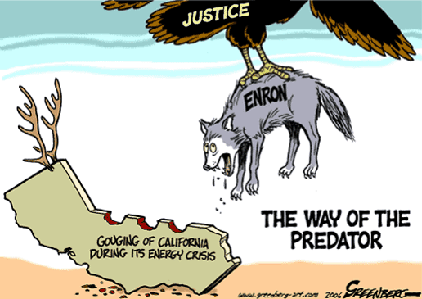 Most the public never even knew the extent of the national plan to deregulate the entire US electric market. Enron had been setup as the lead player with insiders predicting that only a handful of giant electric companies would be left to kill any state control over the mega companies that would come out of the electric power bubble. Well, of course we all know what happened with that one. California got robbed by Texas bandits to a tune of up to $17 billion in 2001 with Enron going bankrupt months after PG&E did, the largest electric company to go bankrupt since the Insull Empire (now known as Exelon) in 1932. Most folks in the state didn’t know that the newly completed merger between Chevron and Texaco had resulted in their takeover of another electric company called Dynergy, that in turn was in negotiations to merge with Enron when they collapsed days before 911.
Most the public never even knew the extent of the national plan to deregulate the entire US electric market. Enron had been setup as the lead player with insiders predicting that only a handful of giant electric companies would be left to kill any state control over the mega companies that would come out of the electric power bubble. Well, of course we all know what happened with that one. California got robbed by Texas bandits to a tune of up to $17 billion in 2001 with Enron going bankrupt months after PG&E did, the largest electric company to go bankrupt since the Insull Empire (now known as Exelon) in 1932. Most folks in the state didn’t know that the newly completed merger between Chevron and Texaco had resulted in their takeover of another electric company called Dynergy, that in turn was in negotiations to merge with Enron when they collapsed days before 911.
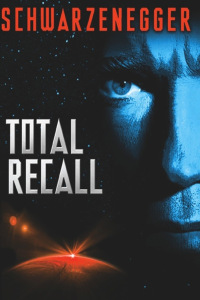 It stinks to high hell that Governor Davis would be recalled just prior to his plans to carry out a state sponsored prosecution case of all the electric companies involved, which was quickly dropped after the Governator won the seat. It was still one of the most astonishing media moments in history when every night for nearly two months prior to the election at least one of the Cable Channels were playing his infamous movie called “Total Recall”..
It stinks to high hell that Governor Davis would be recalled just prior to his plans to carry out a state sponsored prosecution case of all the electric companies involved, which was quickly dropped after the Governator won the seat. It was still one of the most astonishing media moments in history when every night for nearly two months prior to the election at least one of the Cable Channels were playing his infamous movie called “Total Recall”..
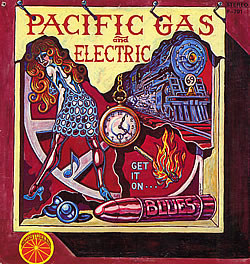 An attempt to stop the ripoff of the taxpayer’s $28 billion happened in 1998 as Ralph Nader and consumer activists across the state put an initiative on the ballot, in an attempt to stop the give-away, But PG&E and the other utilities would spend $40 million to defeat the state wide initiative. The two biggest companies would then take the money and invest it in out of state resources that they would all but lose after PG&E’s bankruptcy and SCE near miss after the Texas invasion in 2001.
An attempt to stop the ripoff of the taxpayer’s $28 billion happened in 1998 as Ralph Nader and consumer activists across the state put an initiative on the ballot, in an attempt to stop the give-away, But PG&E and the other utilities would spend $40 million to defeat the state wide initiative. The two biggest companies would then take the money and invest it in out of state resources that they would all but lose after PG&E’s bankruptcy and SCE near miss after the Texas invasion in 2001.
Wow! All of this just because of the state’s nuclear fiasco! Yup, brought to you by no major media outlet anywhere again, of course.
Back during the Abalone Alliance’s massive blockade in 1981, the group gave permission to let the action be filmed for a documentary which was finally completed shortly after the Chernobyl disaster by a local film producer, David Brown. Well, imagine, what an appropriate film that should have been shown, detailing all of the major controversies around Diablo Canyon and the anti-nuke movement at its peak!
Well, it was never to be shown by the major PBS station in Northern California unless they snuck in a late night time slot when most the region was asleep, simply because that station had long been taken over by San Francisco’s corporate operatives. You might call them the Chevron station and people would know who you’re talking about. A couple of the smaller PBS channels in the region have shown it over the years, but this kind of overt censorship is clearly all about the back story of how private ownership of this country’s electric policy has long been used to subvert the country’s electric policies by our favorite power boys here and across the nation.
Nuked Politics
Today, most the people wouldn’t even know there ever was a movement in California, let alone nationwide or in many countries around the world. And this is also the case for the historic roots of Green Parties around the world that started with the formation of Die Grunen or the German Green Party in the late 1970’s.
Germany’s anti-nuclear movement saw the importance of unifying activists across all environmental issues as the foundation for building a political response to corporate influence over Germany. This broader vision to unite all environmentalists to counter runaway corporate greed had dramatic impacts on Germany. Not to mention the country’s decision to phase out nuclear power. This vision was spread to the US as activists in Europe visited us in the early 1980’s and at the Abalone Alliance’s offices, igniting the hopes of a similar campaign here.
 California would be prominent player, from the movement organizing phase and its SPAKA process. The state would be the first to go for party status in 1990. The idea of unifying environmentalists would be far harder to manage here as a result of economic and political realities on the ground. The two party system for example immediately initiated tactics like buying off activists, dangling good pay and more power to those either became disillusioned with the daunting challenges of taking on the big boys. Sadly, a rift between the direction of the US Green Movement was evident when Green reps decided to form the state party at Fresno.
California would be prominent player, from the movement organizing phase and its SPAKA process. The state would be the first to go for party status in 1990. The idea of unifying environmentalists would be far harder to manage here as a result of economic and political realities on the ground. The two party system for example immediately initiated tactics like buying off activists, dangling good pay and more power to those either became disillusioned with the daunting challenges of taking on the big boys. Sadly, a rift between the direction of the US Green Movement was evident when Green reps decided to form the state party at Fresno.
At the center of such a major project was and still is the tensions between the initial Green vision of a grassroots model vs. the largest environmental groups that had their own agenda, moving to Washington D.C. as “legislative reformists”. The idea of a bottom up (democratic process) vs. top down set of values fell on deaf ears. During the Committees of Correspondence phase of the party in the 1980’s, the vision of how to proceed was slow simply because the country is large and the issues, not to mention the volunteerism involved always creates real issues of elitist behavior. A problem German activists didn’t have to deal with as they could take a train ride to a meeting in just hours. In the long run the well funded Beltway non-profits had no interest in the Green Agenda, playing a major role in its failure to move beyond a few pockets of success nationwide. Ralph Nader’s candidacy, including the now infamous theft of the 2000 election by the U.S. Supreme Court, couldn’t have been a finer moment for the democrats to blame for their own failure on the Greens.
Even so, the movement to create a model founded on Die Grunen’s core principle of stopping nuclear power hardly made it across the Atlantic. But probably more problematic was the wholesale shift from envisioning a broader change in building a green future might entail at the grassroots, the greens energy was sucked up almost exclusively into the daunting battle to get on the ballot, almost completely abandoning any kind of grassroots campaigning on the real issues as they happened.
The idea that well funded environmental groups or that the grassroots would drop what they are doing and involve themselves with the Green’s policy crunching model never caught on other than in a few cities. The peak of the Green Party’s days would be winning control of a handful of cities in California and nearly winning the mayoral contest for the city of San Francisco in 2003. Sadly, we live in a culture that distrusts politicians, but has to deal with entrenched special interest groups whose bottom line has become monetized by the continuing inflationary spiral of wealth moving upward to the very wealthiest. Green values are great, and we can thank them for always having an anti-nuclear plank. We could have used an organizing model to help carry on the real battles at hand however.
How Yucca Mountain Nuked the 2001 energy crisis in California
In a rather arcane but dramatic story that has seldom been mentioned, during W’s election campaign he would promise the state of Nevada, one of a handful of swing states for the 2000 election, making the promise to the state’s voters that he would under no circumstances let the Yucca Mountain nuclear waste dump be licensed unless there was good science in place. Well, of course with 99% of all the media coverage of that state’s long battle with the Dept. of Energy over the dump, their version of good science was clearly different than Mr. Bush’s. He would win the state and thus the electoral college, and then in one of his first actions okayed the go ahead for Yucca Mountain High Level Waste Repository. Senator Reid would be outraged, calling the president a liar publicly. But Reid would go one step further, he would convince Republican Senator Jeffords of Vt. to leave the republican fold and become an independent right at the height of invasion of California. Resulting in the republicans losing all of their major control over the key committees that were holding Bush’s intentional agenda to not put price caps on the natural gas going into California. Within weeks, the invasion was over and the sordid event was quickly buried by the 911 disaster.
The battle continues of course. With the federal government, our own version of Japan’s Nuclear Village” passing just about anything the industry desired including legislation that forced the country to break up into groups of state compacts, each state taking its turn at being the home to its members nuclear wastes. The country had been carved up into thirteen compacts. Each compact would have until 1992 to pick a dump location and get it operational. This, of course led to a national campaign in all thirteen compact regions to block those dumps and we won in every single case, even Texas Governor Bush eventually blocked a dump there.
Even the very undemocratic move to force the country’s worst waste – spent nuclear fuel would eventually backfire as the stat of Nevada would mount a 20 year battle to stop Yucca Mountain from going ahead. Near the end of the battle the Dept. of Energy even considering bring all the spent fuel waste through California as Nevada had blocked all routes from the east while routes in from the north were block by tribal rulings. It would be one of our governor’s last legal chores as the state attorney to monitor that case and oppose the plan – Good ol NIMBY action Jerry! He must have nightmares of his former incarnation as a Zen dude now turned pro-nuke real estate puppet…
The Ward Valley Nuclear Waste Dump Battle 1990-98
But pretty much the longest and most difficult battle took place in California literally taking over a decade before the plan to put a dump right over the top of the Colorado aquifer near Needles California was finally laid to rest. Don’t Waste California, named after other similar campaigns across the country was formed in September, 1990 just weeks after the first successful strategy of delaying the Bureau of Land Management Environmental Impact Statement took place. By early November, Southern California was brought into the campaign. Next spring, Greenpeace would join the battle. The final victory would come with the organizing of six different tribal groups that lived near the proposed dump. They would eventually set up a two year long encampment on the site that finally outlasted Governor Pete Wilson’s promise to open the dump, but going beyond his last term of office. The new governor, Gray Davis, who was brought into help block the dump early on would finally order it killed.
Along the way there were any number of major victories including getting legislation that required large tritium producers in the state to recycle their wastes rather than just dumping it. The battle included all kinds of groups because the site was also right in the middle of the endangered Desert Tortoise’s turf. A retired, republican physicist from Needles would take on much of earliest burden, going to a national convention where he would meet Dr. John Gofman who in turn gave him this author’s phone number barely 30 days before it was all over.
The old Abalone Alliance clearinghouse office would spend just about all of its last money to send out a statewide alert, getting enough comments into the BLM to win the initial 90 day delay on the EIS. From then on, there would be one skirmish after the next with US Ecology, the dump company, or various state and federal agencies. Including an emergency declaration by Bush senior in attempt to push the dump through as his last ditch lame duck act. But incoming president Clinton would call off the emergency, letting the campaign to stop the dump go on for nearly 5 more years after that.
There was one of those moments that played an important moment when Senator Steve Peace, who was a major part of the push to open the dump was heard to joking with other members of the state oversight committee about “dumping it on the indians”. Peace, would become notorious for his role in promoting the state’s energy deregulation scam that backfired the harshest in his own home county of San Diego – also Pistol Pete Wilson’s…
 The battle to stop San Onofre had a similar flavor to it with support going statewide, and even nationwide after MUSE held a fundraising concert in the fall of 2011 in the bay area, over 30 years after the first one they did at Madison Square Gardens, bringing activists together to launch the Nuclear Free California campaign. Just as the Abalone Alliance would struggle with the immense size of the state, even with offices in just about every major city, its hard to keep such a major undertaking underway simply because grassroots organizing is usually out of people’s pockets, with literally no serious funding. Most folks involved in such events are working with their own cash, spare time and dedication.
The battle to stop San Onofre had a similar flavor to it with support going statewide, and even nationwide after MUSE held a fundraising concert in the fall of 2011 in the bay area, over 30 years after the first one they did at Madison Square Gardens, bringing activists together to launch the Nuclear Free California campaign. Just as the Abalone Alliance would struggle with the immense size of the state, even with offices in just about every major city, its hard to keep such a major undertaking underway simply because grassroots organizing is usually out of people’s pockets, with literally no serious funding. Most folks involved in such events are working with their own cash, spare time and dedication.
In the middle of the campaign to stop San Onofre, word came out that PG&E had quietly pushed through plans to carry out months of incredibly damaging underwater 3d seismic testing offshore of Diablo Canyon. Over the period of just 5 months activists rallied a major campaign that resulted in the California Coastal Commission blocking the permit to carry out the tests.
For a bit more on the San Onofre battle, see Sayanara San Onofre…
Major groups usually have few resources and even less for nuclear issues, due to the immense political influence the nuclear industry has had in painting opponents as just a bunch of hippies or nut cases. Of course, the truth is far beyond that as most of opponents usually require any number of professional skill-sets to take on the complex nuclear issues involved. If there had ever been a funding mechanism at the federal level to help cover the public’s costs of mounting serious legal challenges at the NRC, there probably wouldn’t be a reactor left anywhere in the US left standing today.
In rare moments, the nuclear industry will occasionally acknowledge that the movement played a major role in pushing the nuclear facilities across the country to operate safer. But not since the Forbes Magazine called the nuclear industry the largest managerial disaster in US financial history have we really gotten the kind close shave these mad scientists emanating from the Dept. of Energy deserve.
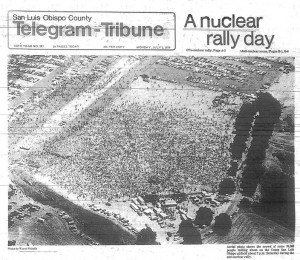 So from 1958 when a housewife and handful of citizens eventually linked up with the Free Speech movement not far away at Cal Berkeley… To the counter culture, rock music, and the anti-war movement’s activism in the 1960’s and 1970’s, that helped bring over a million people in New York City for a week long event after Three Mile Island. The first big event in California was on April 7th 1979 where 25,000 in San Francisco showed up, then 50,000 in San Luis Obispo in June of 1979!
So from 1958 when a housewife and handful of citizens eventually linked up with the Free Speech movement not far away at Cal Berkeley… To the counter culture, rock music, and the anti-war movement’s activism in the 1960’s and 1970’s, that helped bring over a million people in New York City for a week long event after Three Mile Island. The first big event in California was on April 7th 1979 where 25,000 in San Francisco showed up, then 50,000 in San Luis Obispo in June of 1979!
This was the moment when young people in California got organized and turned the premier pro-nuke state in the country into just the opposite, with nukes from Blythe and Ward Valley in the east, Malibu in the south and Humboldt in the north being stopped or forced to close. It’s a proud history and frustratingly for those who participated, barely even known today, thanks to the same tactics that were used to bury an even bigger battle that raged across the country from California to New York City from the 1880’s to the 1940’s – The Public Power vs. Private Power battle, with its last great hero being Franklin D. Roosevelt. Dare look for anything on this 60 year war… Yet under every stone from the name of Hoover Dam to the great depression power projects that helped put millions of Americans back to work – few have a clue about it thanks to the banks, book publishers and our wonderful friends at Morgan and GE. Younger folks may not remember this but it was Ronnie and his wonderful job as the master of ceremonies during the GE hour (Progress is Our Most Important Product) that points to just how successful the media has become in burying this all important part of our past.
Yes folks, it was the no-nuke movement that made California a global leader in energy efficiency and renewables. But of course not all was rosy mind you. It would be the electric industry’s revenge to kill these programs and nearly did so. From Reagan’s cut off of all funding for these programs that led to the collapse of the world’s largest wind company in the bay area, to SoCal Edison’s legal maneuver under the Clinton administration to kill all PURPA renewable energy programs, not to mention the car industry’s intentional destruction of the electric car development planned in the state, and of course the agenda to kill the fast train from L.A. to SF as well. I still remember hearing how Ronnie Raygun would claim during his radio talk shows that all the nuclear waste produced in the country could fit into his garage! It was their outrageous lies (remember too cheap to meter) and many more that gave people a rallying cry to fight them. And of course the new wave of these nuclear puppetmasters continues to turn out new PR scams all at ratepayer’s expense.

